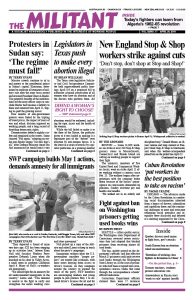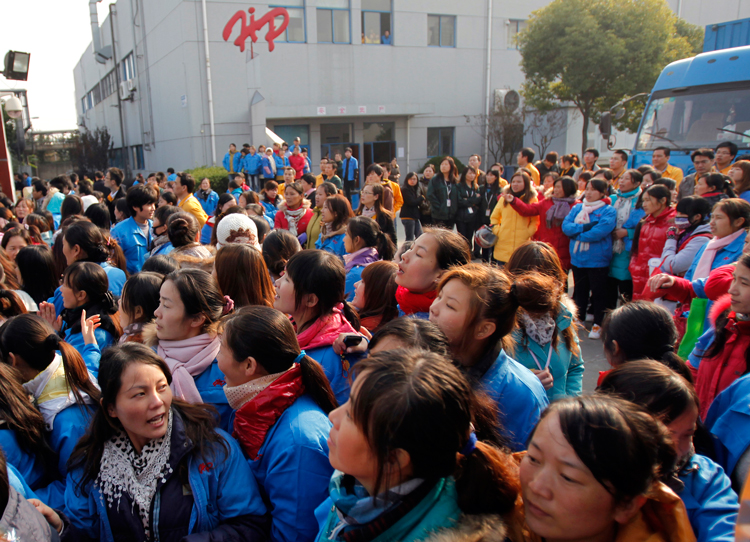The Book of the Month this week is Capitalism’s World Disorder: Working-Class Politics at the Millennium by Jack Barnes, national secretary of the Socialist Workers Party. The excerpt below, from “Youth and the Communist Movement,” foresaw much of the way the vast urbanization and industrialization in China would unfold, as well as expanding international competition and potential workers’ struggles this would unleash. This process was just beginning in 1992 when the talk was given. Copyright © 1999 by Pathfinder Press. Reprinted by permission.
We should never underestimate how attractive the Chinese revolution remains to hundreds of millions of toilers, especially to peoples of color long oppressed and exploited by imperialism. Despite the crimes of its Stalinist misleadership, China stands as an example of a people — more than a billion strong, abused by both European and Asian imperialist powers for more than a century — who carried out a powerful revolution, swept aside the landlord and capitalist exploiters, and restored their national sovereignty and dignity.
Today, more and more toilers in China are being drawn out of the countryside and into factories, mines, and mills owned by the state and increasingly also by foreign and domestic capital. As this process unfolds, the breakdown of Stalinist apparatuses that we have seen in Europe and the former USSR will inevitably shake the deformed Chinese workers state as well. It will take time, but class tensions and conflicts are already growing in China’s cities and workplaces, as well as in the countryside. And when the day comes that a young and rapidly growing working class enters into combat in larger battalions, the Stalinists will find that their bloody suppression of the Tiananmen Square youth rebellion in 1989 cannot be endlessly repeated. The struggles that are coming, whatever their tempo and exact forms, will be larger and more explosive than anything in China since the revolution itself.
Hong Kong should be of special interest to us, as we meet here in the home base of the declining British Empire. With London’s impending return of that territory to China in 1997, the Tories are coming under hypocritical criticism from other imperialist powers for denying the people of Hong Kong the opportunity for “democracy.” But democracy had nothing to do with the scramble by European, U.S., and Japanese capitalists for more than a century to establish their domination over the enormous Chinese market and source of cheap labor and raw materials. The Crown simply held on a little longer than its rivals to the little hunk of sovereign Chinese territory it stole more than 150 years ago. …
What is really going on is not simply that the People’s Republic of China is about to gobble up Hong Kong. What is happening instead is the “Hong Kong-ization” of southern China.
What is developing in China today is an accelerated expansion of capitalist methods and penetration by international finance capital — the growing sway of the law of value in southern China especially, as well as Shanghai and other coastal areas.
Many of you have probably read newspaper reports about the so-called Special Economic Zones in southern China, where much of the imperialist investment is concentrated.
These zones are located in huge, and growing, population centers. The Shenzen and other Special Economic Zones in Guangdong [Canton] Province and the Pearl River Delta, around Hong Kong, are in an area with about 80 million people. …
[T]hat is the goal of the dominant wing of the bourgeois-minded bureaucratic caste in China. Desperately poor peasants are being drawn from the countryside and into the cities, where to survive they are forced to work long hours, under extreme speedup, for minimal wages in both state- and capitalist-owned factories. In the medium term, these conditions will permit a relatively rapid economic expansion.
The Tories did not send Chris Patten, the former party chairman, to be the new governor of Hong Kong as a throwaway. The imperialists are already fighting over which of them will get the biggest shares of investment in China — and British capital is already losing out to its rivals in Tokyo and on Wall Street, and even to capitalists in Taiwan and Singapore. Hong Kong capital itself accounts for well over half of all foreign investment in China. …
The Japanese, U.S., and other capitalists investing in China think they have died and gone to heaven. They have most of the rights of capitalists, but the state “handles” the workers for them. The state, including the Communist Party and its functionaries, makes sure the workers do not get out of line on the job, do not strike — do not do much except work very hard, for very long hours, for very little pay. It seems like a dream!
Of course, the dream will not last. As capitalist exploitation increases throughout China, so do strikes, peasant protests, and attacks on bosses. …
Workers in China will conduct more fights like these, and they will eventually link up with dissatisfied peasants and also win support from young people attracted to the working class as the force that can revitalize society. That will be the real bloc. It will be forged through enormous class battles, and as that happens growing numbers of fighters will be open to the ideas of the communist movement.
In preparing for what is coming in Asia, we should remember that there is a big difference between the position of United States imperialism in that part of the world and its position in Europe. …
In Asia … Washington still has to bring its power to bear under conditions more comparable to the 1920s and 1930s. U.S. forces intervene militarily in the region, of course, and some 100,000 U.S. troops are stationed in Japan, Korea, and aboard warships afloat in the Pacific. But U.S. imperialism is not integrated as the dominant force in any Asian military alliance with other powers. That makes U.S. armed intervention in Asia less “legitimate” and thus more explosive, and the reactions to such aggression across the region will be explosive as well.
The United States ruling class is armed to the teeth and will not back off being the world’s top cop.


